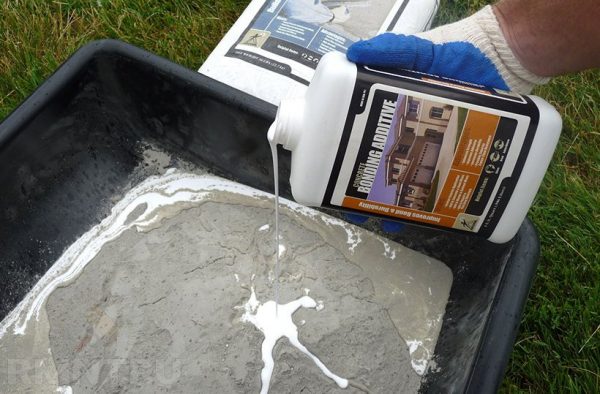Concrete is a popular building mixture based on sand, cement and gravel. It can be used in its original form, but various additives are often added to it to improve its technical characteristics. Additives in concrete can increase strength, accelerate or slow down the curing of the mass and perform a number of other functions.
- Why concrete additives are needed
- Varieties of additives
- Modifiers
- Plasticizers
- Stabilizers
- Mobility controllers
- Frost resistant additives
- Water-repellent additives
- Anticorrosive substances
- Chemical additives
- Additives in concrete for strength gain
- Curing additives
- Hardening retarders for concrete
- Self-sealing additives
- Additives for gas formation, foaming and air entrainment
- Pigments
- Other concrete hardening methods
- Hardening impregnation
- Dry hardeners
- Supplement manufacturers
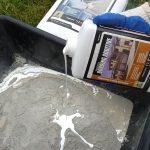
Why concrete additives are needed
Any concrete mix necessarily includes water: after contact with the liquid, the mineral base turns into crystalline hydrates and becomes capable of forming a solid cement stone. The behavior of the cement mortar is influenced by external factors: ambient temperature, humidity, and sometimes the conditions for its curing are not the most favorable. Special additives for concrete help to change its properties over a wide range, which facilitate the work of builders and improve the quality of finished structures.
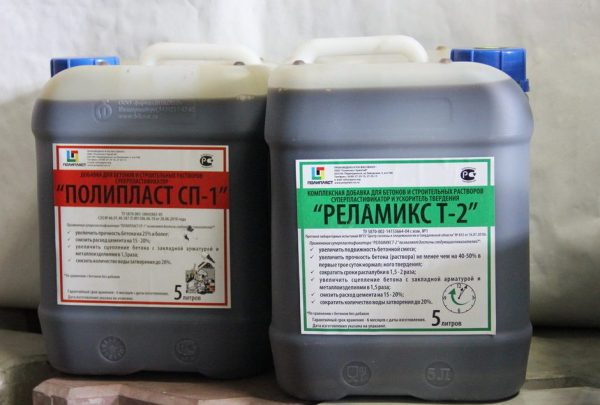
Additives can significantly improve the technical parameters of mixtures, optimize the conditions for setting, hardening, aging, gaining maximum strength. Various chemical additives are capable of:
- level the effect of destructive substances: salts, water, chemistry;
- reduce costs and overall financial expenses;
- increase heat resistance, frost resistance;
- speed up work;
- enhance adhesion;
- increase fluidity or density;
- prevent cracking.
Varieties of additives
Additives for concrete are made in the form of liquid solutions, concentrates, dry mixes. Also, all additives are divided into chemical and finely ground. The first are powders, liquids, emulsions based on synthetic components that are introduced into concrete in a minimal amount. The second save cement consumption in the solution and are made from mineral substances, waste from various industries. They play the role of fillers and are added in a rather large volume.
to contents ↑Modifiers
Modifying additives can give concrete different properties. In fact, various additives are combined under this name: to increase strength, to be waterproof, to give frost resistance, to extend the life of the structure. They are selected depending on the purpose of the concrete, which can be used for completely different purposes (screeds, foundations, wells, pools, other structures).Usually, after the introduction of complex modifying additives, the solution lays down more evenly, fills even small gaps, recesses.
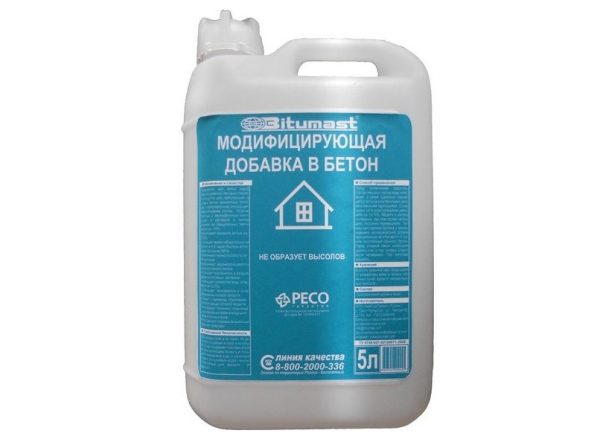
Plasticizers
It is a mistake to think that the concrete mixture is sufficiently plastic, the main thing is to pour the right amount of water into it. In fact, the water-cement ratio, or the accurately calculated amount of water per unit mass of cement, must strictly correspond to the technology for preparing the solution. Only in this case the mass will gain maximum strength. If the water norm is exceeded, the porosity of the concrete will increase and its quality will drop sharply. As a rule, only 4-6 liters of water are added per 10 kg of dry matter.
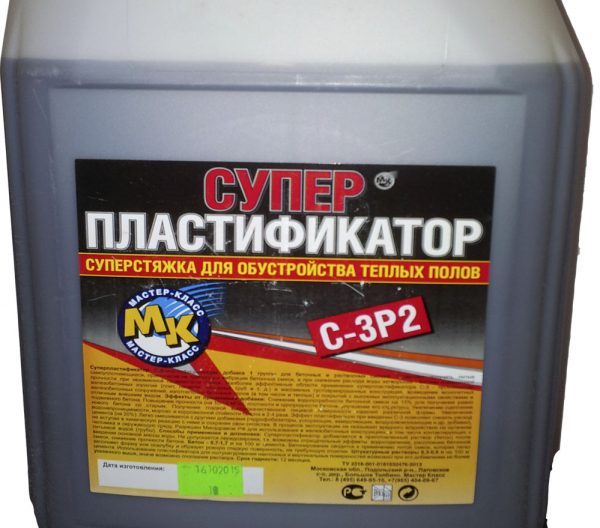
In order to be able to give plasticity to a rather thick mass, special plasticizing additives are used. They help to make the solution fluid, mobile without introducing an additional volume of liquid. Plasticizers reduce the adhesion between the particles of the mixture, do not allow it to delaminate, in addition, they can reduce cement consumption by 10% without loss in quality. The strength of the action of plasticizers is divided into several types:
- weak
- medium;
- strong;
- super plasticizers.
Stabilizers
Such additives are used to strengthen the strength of concrete, strengthening its structure. They can reduce the delamination of the mixture, improve the viscosity and homogeneity, do not allow the dye to flow out (if the solution is pigmented). Also, stabilizers increase the service life of structures, since the latter become less susceptible to mechanical wear and damage. Most often, such additives are made on the basis of microfiber, cellulose, basalt, polypropylene.
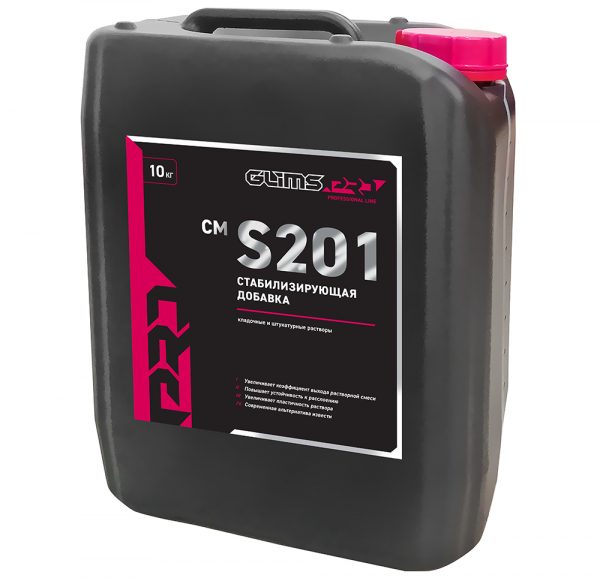
Mobility controllers
These concrete additives are required if the mixture has to be transported over long distances. They prevent the setting of the mortar before the set time. The use of mobility regulators in the summer period is especially important, because concrete hardens faster at high air temperatures.
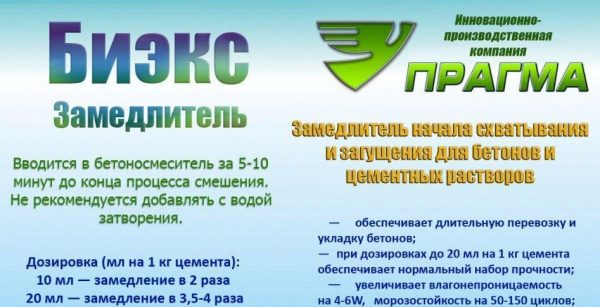
Frost resistant additives
You have to work with concrete in the cold season. Some additives help make the solution suitable for pouring at temperatures of –15 ... –25 degrees. They give antifreeze properties to water, so the freezing temperature of the liquid changes. Most often as such substances are used:
- sodium nitrate;
- sodium chloride;
- calcium chloride;
- calcium nitrate;
- urea.
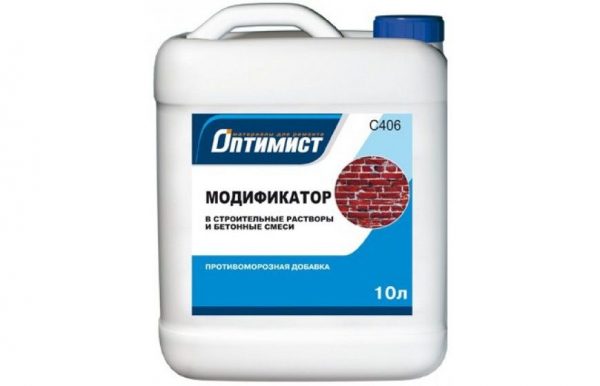
Water-repellent additives
Substances that provide concrete with hydrophobic properties (the ability to repel water molecules) are called hydrophobic additives. Their addition is especially recommended when the mixture is intended for pouring the foundation, because it should prevent water from entering the main structure. After the introduction of waterproofing additives, you can not apply bitumen coating: micropores of concrete will practically cease to allow moisture to pass through.
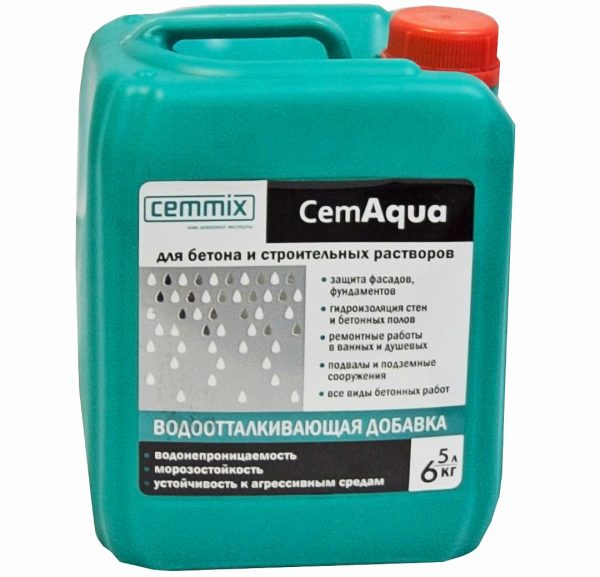
to contents ↑The most famous waterproofing additive for concrete is water glass, but its amount in the solution should be quite significant. Now there are more advanced additives that reduce the moisture permeability of structures, for example, Penetron. Such substances crystallize and overlap the pores in the concrete mass, and also have the ability to protect the reinforcement from destruction.
Anticorrosive substances
After the introduction of such compounds into the solution, the aggressive effect of external factors on the iron frame of the structure is reduced. This leads to an increase in the service life of concrete stone, and at the same time prevents the washing out of concrete hardeners, increases its density and moisture resistance.
Chemical additives
Chemical additives include most plasticizers, modifiers, water repellents and other compositions that are introduced into the concrete mix.There are also special additives for the prevention of crushing of concrete stone and stratification of the mortar, mobility modifiers and agents that hold moisture inside the mass until it solidifies.
If necessary, special antifungal compounds are used as additives for concrete, which reduce the risk of mold at the joints and areas that are often exposed to water.
to contents ↑Additives in concrete for strength gain
Sealing additives, or colmatizing, are designed to clog pores in concrete with water-insoluble particles. As a result of their use, the density of the solution increases, therefore, its wear resistance, durability, and moisture resistance increase. Typically, such additives are mineral fillers: calcium nitrate, iron nitrate, iron sulfate in an amount of not more than 3% of the total mass. Also, for gaining strength, TEG – 1 or DEG – 1 resins (1–1.6%) can be introduced into concrete.
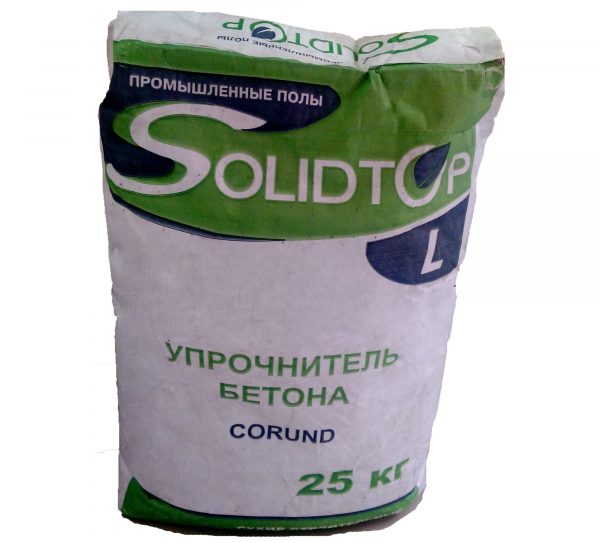
Curing additives
These substances are needed for the need for quick solidification of concrete after pouring it. They are able to increase the hydration rate of concrete stone in natural conditions and are most often used for cementing structures in winter. Suitable properties are electrolytes, which are introduced in a volume of 0.5-3% by weight of concrete.
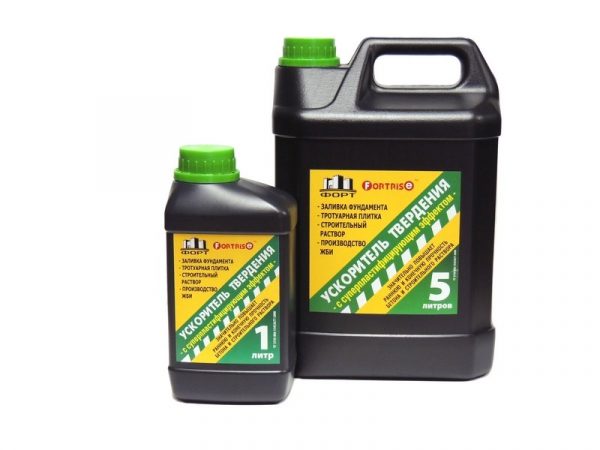
Hardening retarders for concrete
As a rule, retarders are required when concreting large, massive structures, for example, floors or foundations, because the technology requires that all the concrete remains liquid until the process is complete. If you do not introduce a hardening additive, the first sections will begin to harden before the last, which will weaken the structure in the future. Without the introduction of additives, you will have to handle the joints of the old and new concrete, and this is quite laborious. Typically, concrete curing inhibitors are used:
- milk serum;
- sodium gluconate;
- feed syrup;
- RSB-500;
- nitrilotrimethylene phosphonic acid.
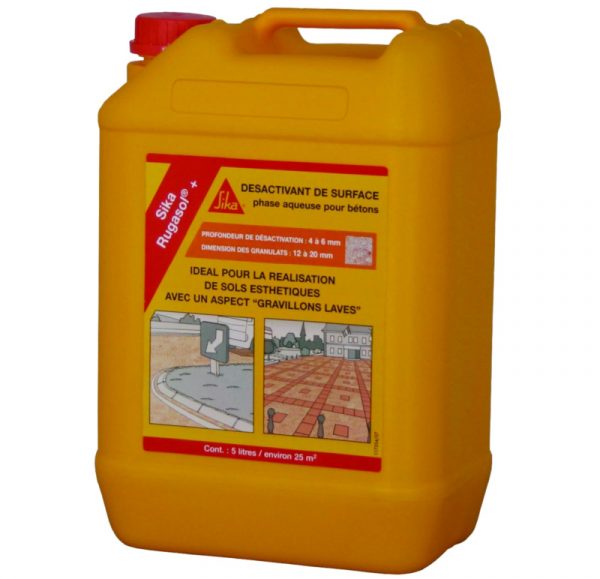
Self-sealing additives
As such additives are super-plasticizers that optimize the mobility of the concrete mass. They are used when pouring structures of small thickness, for example, buildings with thin walls. Such substances help reduce cement consumption without loss of quality, increase the water resistance of concrete stone, increase the strength of the composition.
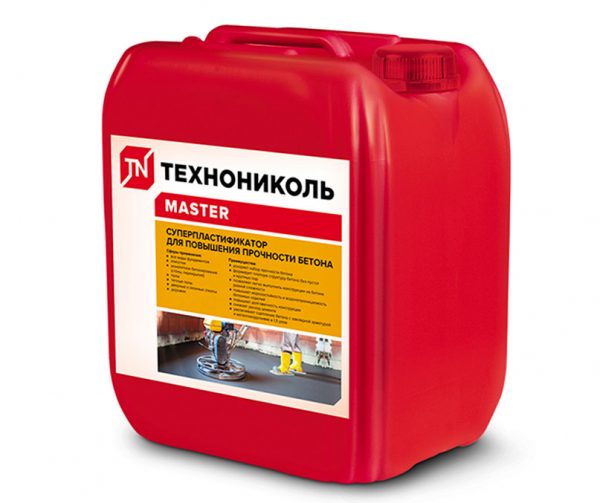
Additives for gas formation, foaming and air entrainment
Air entraining additives are necessary for the formation of closed air pores in concrete. In large quantities, they are harmful, as they reduce strength, but in a small volume, on the contrary, they are useful because they increase the frost resistance of the structure. Water as it freezes literally tears concrete like paper, and if there are air cavities, it has room for expansion, and the degree of destruction of the material is seriously reduced.
The role of air-entraining admixtures for concrete is played by:
- saponified wood pitch;
- petroleum acids;
- salts of organic acids;
- salts of lignosulfonic acids;
- synthetic detergents;
- wood resin.
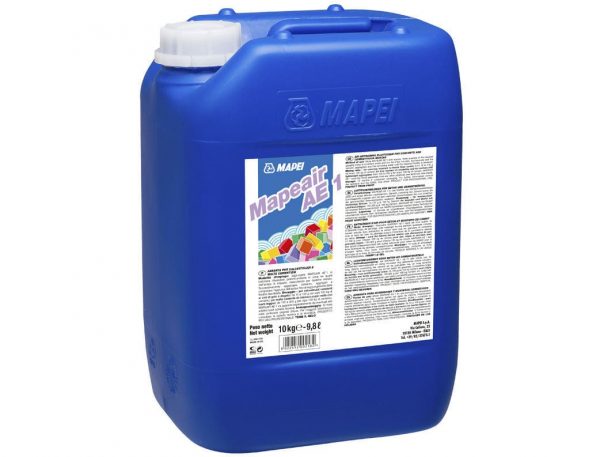
Gas-forming additives work in a similar way. They allow you to get a microporous structure of the concrete mass, although they perform other tasks. Their main goals are to reduce the weight of the structure and increase the heat-insulating properties of concrete. In addition, gas-forming additives (organosilicon substances, aluminum powder) increase the durability of concrete, its tensile strength, resistance to the influence of salts.
Foaming additives are used in the production of foam, gas blocks, their goal is to foam the concrete mixture to create closed cells. Such wall materials have high frost resistance, which is very different from simple concrete. In the form of foaming agents are various synthetic and protein substances.
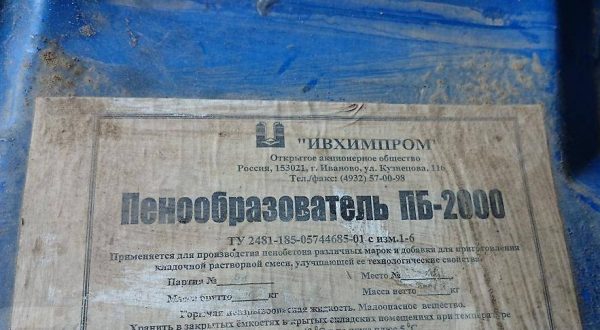
Pigments
Typically, concrete structures do not have an attractive appearance, therefore, in modern buildings, special pigments are often introduced into the solution for its coloring. They are made in a paste, dry, liquid form and can be natural, artificial.
Quality dyes have the following properties:
- fine grinding;
- oil absorption;
- resistance to UV rays;
- resistance to alkali;
- good hiding power.
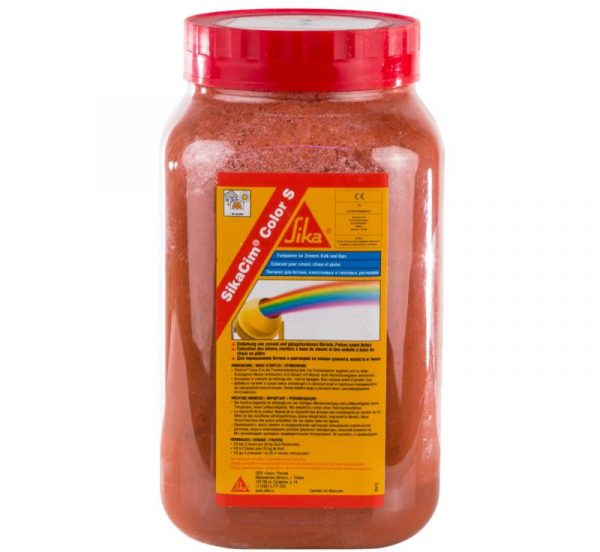
Staining is carried out at the stage of manufacturing the mixture, or spray solutions are sprayed onto the finished structure.
to contents ↑Other concrete hardening methods
Concrete can be strengthened not only with the help of introduced additives, which are used at the stage of mixing the solution. It happens that the structure needs to be strengthened after its readiness or several years after the start of operation. For this purpose, liquid and solid hardeners are used.
Hardening impregnation
Liquid hardeners are made on the basis of water-soluble inorganic compounds. They penetrate concrete to a depth of 3-5 mm, react with it with the formation of more durable compounds. Such impregnations can be applied to any structures that have not been treated with water repellents.
to contents ↑
Dry hardeners
Typically, dry reinforcing additives are prepared on the basis of cement. They are able to increase the strength of concrete up to 70 MPa, seriously increase its ability to withstand tension, optimize wear resistance. Powdered substances are diluted with water and coated with structures, while the service life of the latter increases by 10-15 years.
Supplement manufacturers
Most major manufacturers of cement and building mixtures produce various additives to improve the technical characteristics of concrete. The most popular products are brands:
- Polyplast;
- TechnoNikol;
- Biotech;
- "Fort";
- "Alliance";
- "Superplast";
- MetaPro;
- "Master".
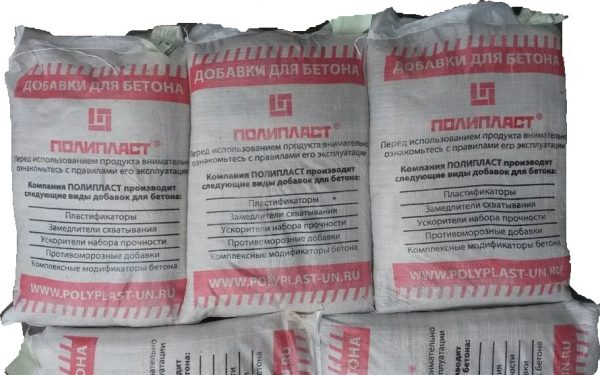
Additives are sold in powders with a packing of 10–25 kg, in canisters of 1–10 l. The average cost of frost-resistant additives is 35–50 rubles / kg, hardening accelerators and retarders are 50–90 rubles, plasticizers are 70–110, and air-entraining additives are 100–300 rubles. The correct use of additives guarantees high strength and long service life of the concrete structure, so saving on additives is impractical.



